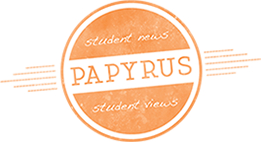Class is a Hoot with Elise Cranston, Rebekah Dothager, and Christy Stackhouse
Written by Kat Kelley.
“And we’re off like a herd of turtles!” Dr. Ahern’s choice of words couldn’t have been more fitting. A week has passed, and many a bird have we seen in Midwestern Birds: Habits and Habitats, although we did get off to a slow start.

Most of our week was spent at the Field Station beginning with a brief lesson in the anatomy of birds, followed by some short treks through the woods to spot local birds. For these walks, we split into two groups. Half of the class followed Dr. Ahern while the other half went off on their own. On the first day, the half that stayed with the professor got to see a Great Horned Owl, the biggest bird spotted in the class so far, swoop down from the trees and glide down the trail ahead of them as they were walking back to the Station building. (Meanwhile, my group was busy pretending to be Lewis and Clark on a new exploration.)

Along with several days spent exploring the woods and trails around the Field Station, we had two field trip days. On Wednesday, we drove out to Patriot’s Park to walk along the trails that most of us had spent hours building during NSO. We couldn’t see many birds around the park, but we could hear dozens of them all around us, including some species we hadn’t identified in the class yet. After Patriot’s Park, we headed to the trails at Iron Gate where the hiking really began. We made it through the mud and over the icy hills to an observation deck where we watched turkey vultures explore the heat thermals above the creek to gain altitude so they could soar away. There was also a huge flock of ducks flying around trying to find a patch of water to land in the icy creek. While watching the birds soar over our heads, we had the pleasure of Dr. Ahern’s childhood memories and stories of the history of the parks as we walked along.
On Friday morning, the class piled onto a GC People Mover and headed out to Carlyle Lake. While we didn’t see as many birds as Dr. Ahern had expected and hoped to see, we did have the pleasure of finding a Bald Eagle perched on a tree. It was too far away to get any good pictures, but Dr. Ahern set up a scope that enabled up to get a close up look at the majestic beast. Other than that, and finding a gigantic pile of Christmas trees to jump in, the last day of the week was pretty uneventful. We drove around Carlyle Lake for two hours, seeing only the occasional Turkey Vulture or American Kestrel, eventually ending up back at the Field Station to study identifying features for our upcoming quiz.

Our adventures around the Field Station at the White Environmental Education Center have taught us many things. We’ve held study skins of the birds we’ve seen; some that had died over 90 years ago, and studied a goose that had a white powder fly from its neck every time we touched it.
Soon, we’ll be giving presentations over the different bird families and take a field trip out to the Mississippi River to, hopefully, get the chance to see some eagles close up.
Photos by Kat Kelley




























